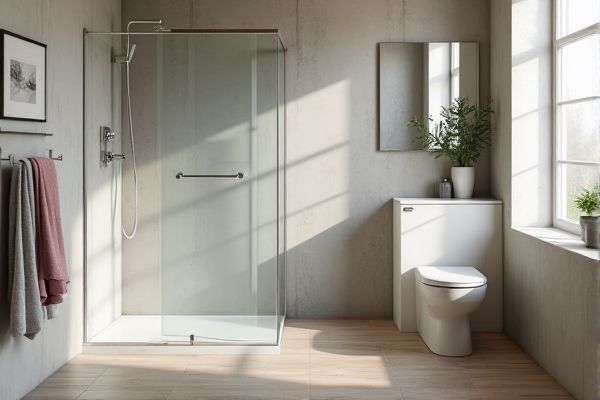
Shower panels offer multiple integrated functions like body jets, thermostatic controls, and hand showers in a sleek design, while shower columns typically focus on a vertical arrangement with fewer features. Discover which option best suits your bathroom needs and enhances Your shower experience by reading the full article.
Table of Comparison
| Feature | Shower Panel | Shower Column |
|---|---|---|
| Design | Slim, sleek vertical panel with multiple integrated functions | Vertical column housing faucet, mixer, and often overhead shower |
| Components | Includes body jets, hand shower, overhead rainfall shower | Usually fixed overhead shower and handheld shower attachment |
| Installation | Mounted on wall, requires plumbing connections behind wall | Wall-mounted, easier retrofit with existing plumbing |
| Functionality | Multi-functional with massage jets and adjustable spray settings | Basic to moderate functionality focusing on shower and mixer |
| Price Range | Medium to high, depending on features and brand | Low to medium, more budget-friendly |
| Space Efficiency | Compact, ideal for modern bathrooms | Compact but less feature-rich |
| Maintenance | Includes multiple nozzles; requires regular cleaning | Simpler maintenance with fewer parts |
Introduction to Shower Panels and Shower Columns
Shower panels and shower columns both serve as integrated bathing systems that combine multiple functions such as rainfall showerheads, handheld sprayers, and body jets to enhance your shower experience. Shower panels typically offer a slim, wall-mounted design with embedded controls, while shower columns often include a vertical structure that accommodates thermostatic controls and varying water outlets. Choosing between a shower panel and a shower column depends on your bathroom layout, aesthetic preference, and desired functionality.
Key Differences Between Shower Panels and Shower Columns
Shower panels integrate multiple functions such as body jets, handheld showers, and thermostatic controls into a single flat unit, whereas shower columns primarily offer a fixed overhead showerhead combined with a handheld shower and basic controls. Shower panels are typically designed for wall mounting with a sleek, contemporary look, emphasizing multifunctionality and spa-like experiences. In contrast, shower columns focus on simplicity and vertical design, often requiring less installation effort and providing a classic shower setup with fewer features.
Design and Aesthetic Comparison
Shower panels feature a sleek, flat design with integrated controls and multiple spray options, offering a modern and minimalist aesthetic ideal for contemporary bathrooms. Shower columns combine a vertical column structure with exposed plumbing fixtures, creating a more traditional yet elegant look with visible knobs and adjustable heads. Your choice between the two depends on whether you prefer a seamless, built-in appearance or a statement piece that adds character to your shower space.
Installation Requirements and Process
Shower panels generally require wall mounting and connection to existing plumbing, making their installation straightforward but dependent on precise wall alignment and water inlet locations. Shower columns often integrate multiple features like thermostatic valves and overhead showers, demanding more complex installation with careful plumbing adjustments and mounting support. Your choice affects installation complexity, with shower panels suited for simple retrofit projects and columns ideal for comprehensive bathroom upgrades requiring professional fitting.
Features and Functionality
A shower panel typically integrates multiple functions such as a rainfall showerhead, body jets, hand shower, and temperature control in a slim vertical design, enhancing the shower experience with versatile water flow options. Shower columns also combine similar features but usually emphasize a sleek, minimalist aesthetic with a fixed overhead shower and a separate hand shower, often including thermostatic controls for precise temperature regulation. Both systems optimize space and functionality, but shower panels offer more comprehensive hydrotherapy options, while shower columns focus on style and essential shower functions.
Water Pressure and Flow Performance
Shower panels typically offer stable water pressure with multiple jets designed for targeted massage functions, enhancing the overall flow performance and user experience. Shower columns, featuring integrated overhead rain showers combined with handheld sprayers, generally provide balanced water pressure that supports a consistent flow without significant drops. Both systems depend on the plumbing setup, but shower panels excel in maintaining varied pressure for spa-like effects, while shower columns ensure steady and even water distribution across different outlets.
Material Durability and Maintenance
Shower panels are typically made from stainless steel, tempered glass, or acrylic, offering high durability and resistance to rust and corrosion, which simplifies maintenance. Shower columns often incorporate a mix of materials like aluminum, plastic, and stainless steel, potentially requiring more frequent cleaning to prevent buildup and corrosion, especially in plastic components. Both options benefit from regular cleaning with non-abrasive products to maintain material integrity and extend longevity.
Cost Comparison and Value for Money
Shower panels typically cost between $150 and $400, offering integrated features like multiple jets and thermostatic controls, while shower columns range from $200 to $600, often providing more customizable options and higher-end materials. Despite higher upfront costs, shower columns deliver better durability and enhanced functionality, yielding greater value for money over time. Budget-conscious buyers may prefer shower panels for affordable all-in-one solutions, whereas those seeking long-term investment and premium experience benefit from the versatility of shower columns.
User Experience and Comfort
Shower panels offer a sleek design with multiple functions integrated into a single unit, providing customizable water flow options for enhanced user comfort. Shower columns, often featuring separate overhead and handheld showers, allow greater flexibility in directing water, improving your overall user experience. Both designs prioritize ergonomic controls, but shower panels tend to deliver a more compact and aesthetically unified solution for modern bathrooms.
Which Is Right for Your Bathroom?
Shower panels offer a sleek, all-in-one solution with multiple integrated features like body jets, hand showers, and thermostatic controls, making them ideal for modern bathrooms seeking tech-savvy fixtures. Shower columns provide a more traditional setup with a vertical frame supporting a fixed showerhead and optional accessories, fitting well in bathrooms with classic or minimalist designs. Choosing between a shower panel and a shower column depends on your bathroom's layout, desired functionalities, and budget constraints.
 homyna.com
homyna.com